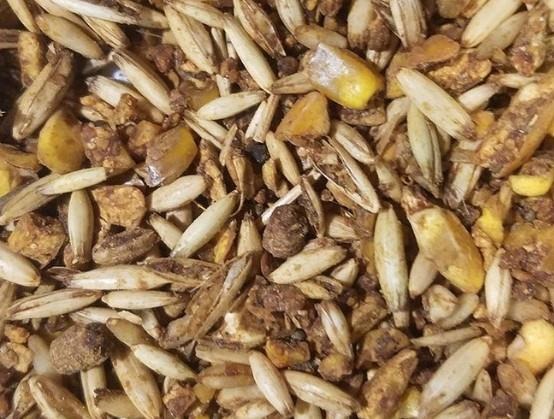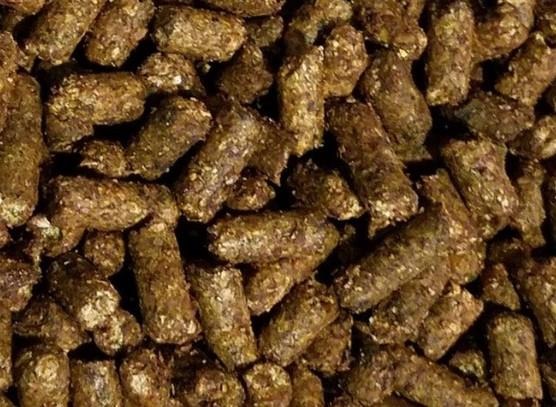By Bethany Bickel
Sweet feed, pelleted feed, oats, corn, ration balancer, oh my! In a perfect, less complicated world, all horses, from pasture pets to growing yearlings to horses in heavy work, could all be fed the same feed. In reality, our horses’ changing nutritional needs throughout various life stages make this concept impossible and require specific diets for each horse.
There are a variety of types and forms of feed that can be fed to horses. The sheer number of choices in the feed store can be overwhelming! Many horses are fed a combination of forage (typically hay or pasture) with a grain mix. Our choices are guided by our horses’ requirements, availability of forages, and cost of feed. Some horses look great on a simple diet of mainly forage, while for other horses finding the right diet to keep them healthy can be difficult. For example, the horse may have a hard time gaining or losing weight. It is important to learn how to feed your horse so that they get all the nutrients they need. Factors that influence a horse’s nutrition requirements include breed, weight, body condition, age, growth stage, breeding status (for both stallions and mares), and performance and training levels. The foundation of any horse’s diet should be forage.
Concentrates
Concentrates include feed such as sweet feed, grains, and pellets, and they are typically added to a horse’s diet to compensate for any nutrient insufficiencies in forages. Working, growing, and pregnant/lactating horses typically need more energy or protein than hay or pasture can offer alone. It may be necessary to provide these types of horses with concentrates. Many “easy keeper” horses do not need grain at all if they are on high-quality forage and many simply require a vitamin/mineral supplement or ration balancer. Horses should be fed concentrates as a supplement to their forage-based diet; remember that horses should be given ~2% of their BW as feed daily, and at a minimum, at least 50% of that feed should be forage.
Grains

There are a number of different grains that are commonly fed to horses. Grains, referred to as ‘cereals’ or ‘cereal grains’ are the edible seeds of specific grasses. The most common are oats, corn, and barley. Milo (sorghum) and wheat are other grains that are fed to horses as well. Grains such as oats, barley, and corn can be fed whole, though many are typically processed to increase digestibility. Examples of how cereal grains may be processed include steam flaking, crimp rolling, extruding, and cracking. Grains are in general low in fiber and high in energy (particularly if processed), but there are differences in the relative amount of different nutrients in each cereal grain. For example, corn is higher in energy than oats or barely. Oats, one of the most popular grains to feed horses, are higher in fiber than corn and barley. Again, processing these grains will improve digestibility; in other words, processing grains will increase the amount of nutrients that the horse can get from the grain. These days, grain is rarely fed by itself as a concentrate; instead, it is often incorporated into pellets or mixed with pellets to make sweet feed.
Commercial Grain & Pellet Mixes
Commercial grain and pellet mixes are another feed option for your horse. They contain a mix of concentrates which provide energy, protein, vitamins, and minerals that are specific are balanced based on a horse’s nutrient needs. Commercial mixes eliminate the guesswork of providing the appropriate amounts of minerals and vitamins in balanced quantities. Adding additional grains to commercial mixes will interfere with the nutritional balance of the feed.
Sweet feed/textured Feed

Textured feeds are a mixture of several cereal grains and molasses (which is why it is often referred to as sweet feed). A balancer pellet is often included providing minerals and vitamins. Other ingredients may also be added such as rice bran, beet pulp and powdered fat. Sweet feed is palatable to most horses. This sweet-smelling feed may mold if stored or kept in hot, humid areas. The addition of molasses eliminates dust and increases palatability.
Pelleted Feed

Pelleted feeds often contain the same ingredients as sweet feeds. The ingredients are first ground, then steam-treated, and then forced through a pelleting die. Pellets stop picky eaters from sorting ingredients in their feed. Pelleted feeds have a longer shelf life and are not as likely to mold. It is important to note that hay pellets are different from pelleted feeds and are considered a form of forage, not concentrate.
Extruded Feed
Similar to pelleted feed, extruded feeds are uniform, and the horse will not be able to pick through the ingredients. It is prepared the same way as pelleted feed but has an additional step where the feed is “cooked” under high temperature and pressure before it goes through a die. This helps to break down some of the structures within the nutrients of the feed. It often has a higher fat concentration than pellets. Texture wise, it is typically softer and less dusty as well.
Complete Feed
“Complete” describes a feed that contains everything the horse needs in his diet, including the forage. Complete feeds can be fed as the sole ration. Senior horses that have lost the ability to chew hay will benefit from a complete feed. Medical conditions may require the use of complete feed, for example when dust or hay irritate the airway. Complete feeds can serve as an alternative option when good hay quality is limited in your area as well.
Ration Balancers
Ration balancers are designed to be fed along with forages to horses that do not need additional energy (calories) from concentrates but do need additional protein, vitamins, and minerals. Ration balancers are a pelleted feed. They typically have low crude fiber and fat. The first ingredient is often soybean meal, making them high in protein. It is a heavily fortified feed with small daily recommended feedings. The purpose of a ration balancer is to provide your horse with the essential nutrients that are insufficient in a forage-based diet. Ration balancers provide a good amount of calcium and other key macro-minerals, trace minerals and fat-soluble vitamins. They are not intended to be fed for extra calories. They often have a high percentage of protein, but this is because such small amounts are fed (1-2 pounds per day). If your horse needs additional vitamins and minerals but not protein, then a vitamin/mineral supplement would be a more appropriate option.
Tips on Feeding Concentrates
When feeding commercial concentrates, make sure to follow the feeding instructions on the label. They are carefully formulated to meet your horse’s needs, but only if you feed the right amount. The label will specify how much to feed based on your horse’s body weight. If you only feed half the recommended amount or dilute it by adding whole grains or mixing in another feed, then the benefit of a carefully balanced feed is gone. You may notice that the feeding instructions are in pounds, not quarts or scoops. If you feed by scoop, use a kitchen scale to figure out how much one scoop of each feed weighs, then figure out how many scoops are required to meet the recommended feeding amount. A scoop of pellets will not weigh the same as a scoop of sweet feed, so do this for each different product in your feed room. Lastly, if you have to cut back a horse’s grain to below the recommended amount because it is gaining too much weight, then consider switching it to a ration balancer instead.
Providing a properly balanced diet for your horse is the most significant part of horse ownership and is a key part of keeping your horse healthy. If you rely on a boarding facility, or if you are the sole caregiver for your horse, it is important to understand how to properly feed them. Your veterinarian, extension specialist, or an equine nutritionist are great resources to aid in developing a diet that meets your horse’s nutrient needs.
Source : psu.edu